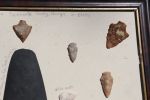Asian, European Arts, Antiques, samurai swords, May 21, 2023
от Eternity Gallery
Контакты аукционного дома
21.5.23
PO BOX 48073 Tampa, FL 33646 USA, Соединенные Штаты
A lot of beautiful arts and antiques from all over the world.
Large collection of swords, including Japanese Samurai swords.
|
ЛОТ 26:
A set of 18 Neolithic flint Arrowheads points + Slate Spade, from Seminole County, Georgia; Provenance: These ...
далее...
|
|








































|
Стартовая цена:
$
200
Эстимейт :
$2 000 - $4 000
Комиссия аукционного дома: 24%
Далее
|
A set of 18 Neolithic flint Arrowheads points + Slate Spade, from Seminole County, Georgia; Provenance: These arrowheads were found in 1960’s in Seminole County, Georgia, USA. A slate spade was found in 1960’s in Hampton County, South Carolina, USA. Collection was put together and framed in 1960’s, sold to antique dealer in 1990s, bought in 2020 from antique dealer in St Petersburg, FL. Size of the arrowheads: from 1.5 inches to 3 inches = 30 mm to 78 mm; Mohs hardness of all flint (chert) arrowheads: 9.5-10.0; Length of slate spade: 9.5 inches = 24 cm; Mohs hardness of slate spade 3.0-4.0; Size of the frame: 18.5 inches x 22.5 inches = 47 cm x 57 cm; Weight of the frame: 1905 g = 1 kg 905 g = 4 lb. 3 oz. Flint is a sedimentary cryptocrystalline form of the mineral quartz,[1][2] categorized as the variety of chert that occurs in chalk or marly limestone. Flint was widely used historically to make stone tools and start fires. Native American Cultural Periods: Earliest Inhabitants Archaeologists believe that humans have lived in Seminole County for at least 12,000 years, perhaps much longer. Clovis and Folsom points, associated with Late Ice age big game hunters have been found in the upper Chattahoochee River Valley. During the Ice Age, herds of giant mammals roamed the river bottom lands. The mastodons, saber tooth tigers, giant sloths and other massive mammals died out about 8,000 years ago. The ethnic identity of the Clovis Culture hunters is not known. They were long presumed to be American Indians, but recent research by anthropologists have revealed many similarities with the big game hunters of Western Europe. An ice cap on the North Atlantic Ocean may have permitted early humans to move back and forth between continents by paddling, while gaining sustenance from hunting sea mammals and fishing. Archaic Period (8,000 BC – 1,000 BC) After the climate warmed, animals and plants typical of today soon predominated in this region. Humans adapted to the changes and gradually became more sophisticated. They adopted seasonal migratory patterns that maximized access to food resources. Archaic hunters probably moved to locations along major rivers during the winter, where they could eat fish and fresh water mussels, if game was not plentiful. During the remainder of the year, smaller streams would have been desirable camp sites. Seminole County was an ideal location for bands of hunters and gatherers. The county’s network of creeks and wetlands provided a diverse ecological environment for game animals and edible plants. Native Americans learned to set massive brush fires in the late autumn which cleared the landscape of shrubs and created natural pastures for deer, bison and elk. The Georgia Piedmont had numerous Woodland bison until they were killed off by British settlers in the mid-1700s. Bison may have also lived on the Coastal Plain in earlier times. The landscape that European settlers encountered in the Chattahoochee Valley was not natural. It had been altered for thousands of years by Native Americans to create optimum environments for the natural production of food sources. Bottomlands were cleared to create agricultural fields. Each autumn, the Creeks intentionally set fires to burn out shrubs and forest undergrowth in order to create grazing lands for deer, bison and elk. Woodland Period (1000 BC – 900 AD) The Etowah, Chattahoochee and Flint River Valleys were locations of some of the earliest permanent villages in North America. A sedentary lifestyle was made possible by abundant natural food sources such as game, freshwater mussels and chestnuts and the cultivation of gardens. Agriculture came very Seminole here. Initially, the cultivated plants were of indigenous origin and included a native squash, native sweet potato, sunflowers, Jerusalem artichoke, amaranth, sumpweed, and chenopodium. The first village farmers of the region are now known as the Deptford Culture. The culture lasted from around 2,500 BC to 100 BC. The oldest known pottery in the western hemisphere was discovered near Augusta, GA on Stallings Island. It was probably made by people associated with the Deptford Culture. Deptford Culture artifacts can be along the South Atlantic Coast, most of Georgia, southern & eastern Alabama, plus the upper Gulf Coast of Florida.

